ABANDONING “BEAUTY”: A Conversation with Roni Chadash
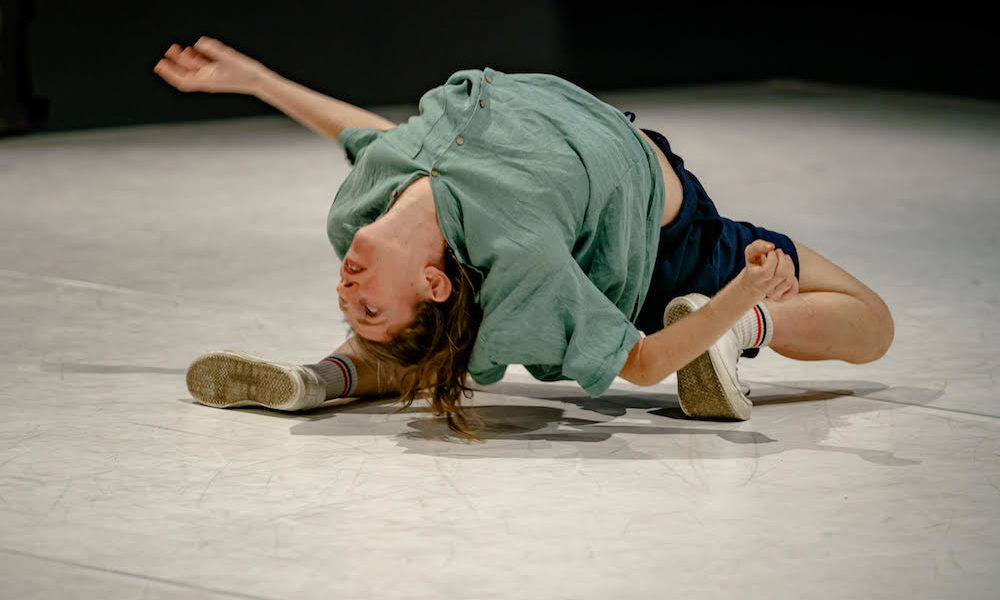
Two years ago, I watched Roni Chadash perform Me, and All That Body as part of the Curtain Up Festival.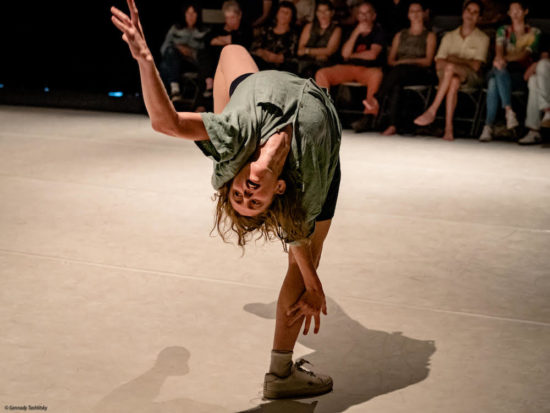 There, in the middle of the then brand-new Studio Zehava, with the audience surrounding her, Chadash arched, fell, rolled, struggled, released, all with seemingly little awareness of the outside gaze. Dressed in a loose button-down shirt, shorts, socks and sneakers, she claimed the space as her own, not to impress or pleasure anyone rather to challenge and express the abilities of her physical being. It was stunning but even more so stunning in contrast to the first time I had seen her on stage.
There, in the middle of the then brand-new Studio Zehava, with the audience surrounding her, Chadash arched, fell, rolled, struggled, released, all with seemingly little awareness of the outside gaze. Dressed in a loose button-down shirt, shorts, socks and sneakers, she claimed the space as her own, not to impress or pleasure anyone rather to challenge and express the abilities of her physical being. It was stunning but even more so stunning in contrast to the first time I had seen her on stage.
Flash back to 2015, the Shades of Dance Choreography Competition at the Suzanne Dellal Center. Chadash, then 24-years-old, alights on the darkened stage of the Yerushalmi Hall dressed in shimmering green leggings and a skintight black top. Her blond hair is pulled back in a bun. For most of the solo Ani-Ma, which won that year’s competition, catapulting Chadash’s career both as a choreographer and as a dancer, Chadash’s face is not seen. She allows her body to do the talking and the language is snake-like, staccato and reminiscent of a contortionist. One could even go so far as to call it sexy.
In the six years since, Chadash has been on a non-stop journey, reinventing and revising her choreographic language whilst performing in works by Israel’s top dancemakers. She has toured extensively internationally, both in works by other artists and with her own creations. Her language has shifted from the lithe, serpentine to a looser, freer and less pretty form of communication. She has created several solos: Goofy, The Same Sea and No-Body, as well as the duet Victims & Images with Carmel Ben Asher and Chapters of Joy, which was performed by a cast of five. She has taught at Tel Aviv’s top studios and has created works for young companies around the country. While her signature has remained clear from the start, her works seem to be growing roots, gaining strength and becoming razor sharp in their intention.
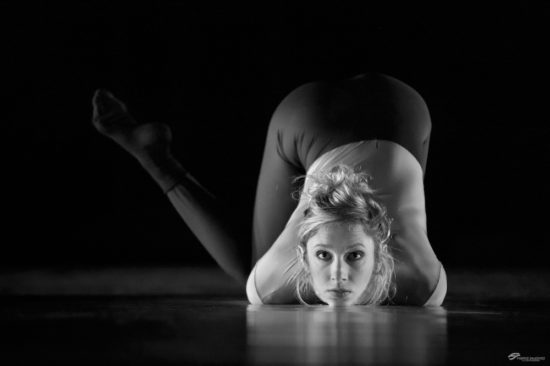 This week, she will premiere a new duet, Body #1, at Habait Theater. The work, performed by Maya Schwartz and Ido Barak, came about during the Corona period and has been shelved awaiting the opportunity to perform. In the same evening, Chadash will perform Goofy, which she created in 2016.
This week, she will premiere a new duet, Body #1, at Habait Theater. The work, performed by Maya Schwartz and Ido Barak, came about during the Corona period and has been shelved awaiting the opportunity to perform. In the same evening, Chadash will perform Goofy, which she created in 2016.
I sat down with Chadash to talk about her journey from Anima to present, how she and subsequently her works have developed over the past six years. We meet in Chadash’s home, a sun-washed south Tel Aviv apartment whose rooftop overlooks the beach as well as Studio Zehava. Her two cats Regina and Serge lounge in the kitchen, aloof yet keenly aware of her movements.
O: Why did you start making work?
R: At first, it was out of frustration. I finished my studies at Ga’aton (the Kibbutz Contemporary Dance Company’s professional training program) and started going to auditions and not getting the jobs. I couldn’t understand why I was learning all of this material and not getting hired. I felt I had a lot to give but couldn’t find where to give it. I guess these are usual young dancers frustrations. I went abroad and attended a bunch of auditions there. I was aware of this deep contrast between the level of the dancers and the choreography being taught. The dancers were such great material and the choreography was incredibly shallow. I thought, ‘if they can do it, I can too.’
I came home and started to work in a studio next to my house in Kfar Shmariyahu. I was alone a lot, for hours. I tried out a lot of ideas and eventually made a video, which I published on Facebook, back when Facebook was personal and smaller. I was very insecure in the beginning. The video got nice responses and, at the same time, I saw the call for applications for Shades of Dance. I took that video and made it into a piece.
O: What has changed since that first piece?
R: Then, I wanted to discover myself. I wanted to discover dance, the relationship with the audience, my body and my physicality. I wasn’t clear to myself then. As I went forward, I started to experiment with my passions through choreography. By the time I made Victims & Images, I felt ready to do something else. Regardless of if I’m in the piece or out or who I work with, I use my work to explore what I’m passionate about.
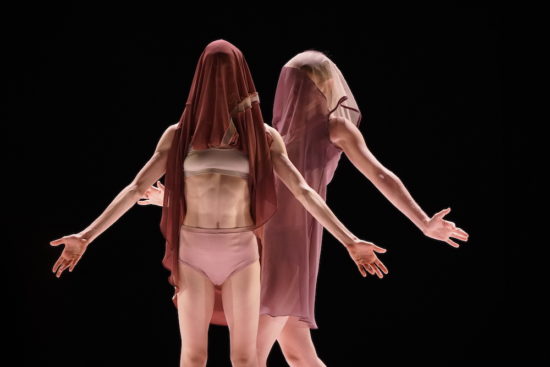
O: There seems to be a shift in your perspective on beauty and the female body in your work.
R: There was a period that I struggled with an eating disorder. I once wanted to make a piece about that actually. I was in a place of selling my body, to auditions and choreographers, and getting no’s. I couldn’t accept my body. I tried to make from it what we think is perfect. In Anima, my thoughts were on how I limit myself. In Goofy, I thought about selling my body to an image. As dancers, we give our bodies over to choreographers, to audiences and to movement. We have to submit and commit to this. There isn’t enough discourse, awareness or openness surrounding the ways dancers have to be available. At the same time as you’re trying to sell yourself to an image, you also have to make a living. People take work because they need it. The money is horrible and you have to be everywhere all the time in order to pay 2500 shekels in rent. You prostitute your body to make ends meet, you say yes to everyone even if you don’t connect to the work.
In my own work, there came a point where I had to ask myself if I was creating for myself or for the audience. That has changed over time for me.
In the past, I need the audience’s approval and affirmation more. There is a balance between pleasing myself and pleasing the audience and it has changed from process to process. I’m trying to learn how to fulfill my own desires. I think that if I’m able to satisfy myself, the audience will also be satisfied.
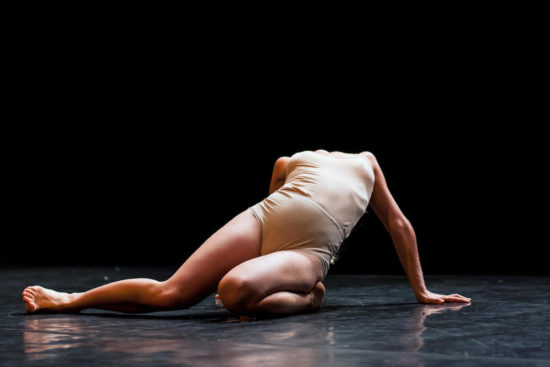
O: Is that what was going on in Me and All This Body?
R: Me and All This Body was the process after the duet (Victims & Images), which was all about the performer/audience relationship. In the solo, I thought that the audience would be a witness to my physical experience and the audience responded as such. Performing the solo is a very meditative experience. It made me consider how my experience is transmitted to the audience.
O: Are you refusing to be beautiful?
R: I feel the desire to stop saying yes to this model in which I sell my body to images and make work to please the audience. Maybe I won’t say no but I’ll say yes to something else. If I don’t want to sell the beauty of my body or my sex appeal, then what do I want to sell? I know I can always go back to beauty and sexiness but, for now, I want to keep looking for the ways in which I want to present myself and my dancers.
O: What is next for you?
R: I’m going to Germany to create a piece on six dancers. It will be my first time creating work for a company, as a commission. It’s also a big group for me. I’m making plans here but I’m waiting to get there to see who the dancers are because they will guide the process.
For more about Roni Chadash, visit www.ronichadash.com.
